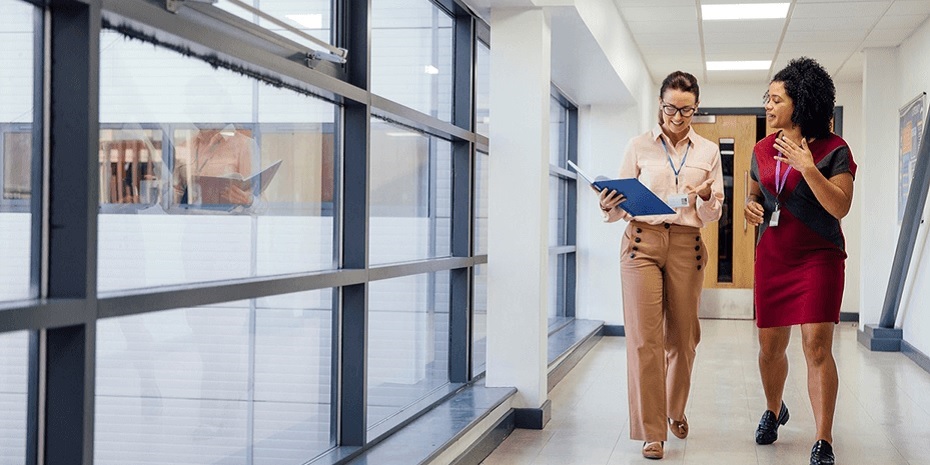
Understanding the Advantages of Asynchronous Learning for Educators
The past two decades have brought rapid technological advances that have transformed the classroom into a hybrid of physical and virtual spaces. A 24/7 connection to the digital world—e.g., the Internet of Things—and the pervasiveness of social media have students immersed in flows of information. To navigate this environment, they need, more than ever, critical thinking, analytics, reasoning, self-awareness, and self-monitoring skills. In an increasingly digital world, they must be self-directed and know how to communicate and collaborate effectively with their peers and teachers.
Teaching these competencies requires a twenty-first-century pedagogy, one that is continually changing. Teachers—those who have been in the classroom for years and those just entering the field—need compelling PD opportunities to learn the strategies for equipping their students with the skills that they need to understand an increasingly complex world.
However, traditional PD programs that present the same training to the entire faculty of a district often fail to provide the discrete skills that teachers need within their subject matter, and these programs do not take into account a teacher’s career stage, resources, and career goals. Traditionally, PD days are infrequent and fragmented. A modern approach utilizes technology to offer asynchronous learning that personalizes training to fit the needs of educators.
What Is the Difference between Synchronous and Asynchronous Learning?
An example of synchronous learning is a classroom or lecture hall where learners gather to learn the same material in the same place at the same time. The development of virtual platforms expanded synchronous learning to enable students to learn the same material simultaneously but from different locations. In-person meetings and virtual conferencing do allow for student interaction, collaboration, and immediate feedback, but with this model, everyone must progress through the same content, whether it’s relevant to their needs or not, at the same pace.
School districts are increasingly turning to asynchronous learning to develop new skills and knowledge. Examples of popular asynchronous platforms are Duolingo language learning, which offers lessons in forty languages to more than 37 million users each month, and Khan Academy, which offers self-paced courses in math, science, computing, and the humanities. Advances in mobile technology have made it easy for learners to select lessons that match their needs and interests. They can move through courses at their own pace when and where it is convenient for them.
For school districts, applying this modern learning model to their PD programs can boost their effectiveness.
What Makes a PD Program Effective?
A Learning Policy Institute report identified several elements of PD programs that have proven to effect change in teachers' practices that improved student learning outcomes.
Effective programs engage teachers and staff with authentic, contextualized materials that incorporate district technology and curricula.
To engage teachers and staff, learning must be relevant. It must apply to specific curricula and technology priorities in the district while considering the career stage, position or department, and available resources. For example, most school leaders recognize that paraprofessionals will need a learning path different from one that is useful to teachers in STEM subjects. Individualized PD that considers an educator's specific needs, rather than generic, everyone-learns-the-same-thing programs is more effective because educators can directly apply their learning to improve instruction in their classrooms.
Learning is interactive rather than passive lecture-based conferences and workshops.
We know that students better retain information when they have hands-on involvement with content and learn in the context of real-world applications. Teachers can also better internalize new learning by actively engaging with new concepts, whether by creating units and lesson plans based on their learning or applying new strategies in their daily tasks.
Learning is progressive and sustains continued growth.
Traditional PD days are generally scheduled twice or three times a year as the school calendar permits. Learning sessions are often presented as isolated units. Effective programs offer continual, cumulative learning, with each lesson growing from the one before. Teachers and staff will strengthen their skills when they can reflect on new concepts, apply them in the classroom, and then use this knowledge as a foundation for further learning.
How MobileMind’s Asynchronous Learning Model Facilitates Effective PD
Individualizing PD and scaling it to meet the needs of an entire district may seem to be an impossible task, requiring hours of work by the development staff. Using multiple standalone apps certainly would be unwieldy. MobileMind addresses this by consolidating and streamlining PD efforts and learning opportunities in one learning hub. With it, districts can develop learning paths and lessons to meet the learning needs of teachers across subject areas and career stages. Teachers can choose a PD learning path that is relevant to them and take micro-lessons from a mobile device or desktop computer at their convenience.
Individualized lessons, compliance training, and onboarding new staff can be managed in one place. There will always be a need for in-person training and group workshops. These PD sessions may also be scheduled within the hub using MobileMind Events. Districts can easily follow each faculty member’s progress, track continuing education hours, and ensure that staff and faculty have completed all state-mandated training.
Asynchronous learning is the twenty-first-century way to learn, and utilizing this approach can boost the effectiveness of a district’s PD program. It empowers teachers to take control of their professional learning journey. No longer will teachers have to leave their students for a day of PD. They can learn whenever and wherever they want.
There is no other modern PD solution consolidating all training efforts while providing a learning hub that streamlines and integrates remote and in-person professional learning for schools. Are you ready to level up your district's professional learning with MobileMind? Schedule a professional learning consultation here.

